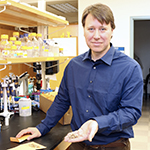New wild alleles to improve peanut

Principal Investigator
David Bertioli, Professor and GRA Distinguished Investigator, University of Georgia, Crop & Soil Sciences Department/CAGT. 111 Riverbend Road, Athens, GA, USA
bertioli@uga.edu
Co-PIs
Daniel Fonceka
ISRA/CERAAS, Thies-Escale, Senegal
daniel.fonceka@cirad.fr
Soraya Leal-Bertioli
University of Georgia, Department of Plant Pathology / CAGT., Athens, GA, USA
sorayab@uga.edu
Scott Jackson
University of Georgia - Crop & Soil Sciences Department/CAGT., Athens, GA, USA
sjackson@uga.edu
Peggy Ozias-Akins
University of Georgia, Department of Horticulture, Tifton, GA, USA
pozias@uga.edu
Incorporating new wild alleles to improve elite West African peanut cultivars
Area of Inquiry: Varietal Development
Country focus: Senegal
Project length: 3 years
Budget: $200,000
Genetic variation in peanut (Arachis hypogaea L.) is limited due to its recent, unique, polyploid origin, which limits crop improvement through breeding. Wild relatives of peanut are a rich source of alleles that have arisen over millions of years of natural selection in diverse environments. However, in early generation hybrids, the valuable wild alleles are masked by the more numerous unfavorable wild alleles that confer poor growth habit, small seed size etc. These “cryptic” favorable wild alleles can be discovered through multiple cycles of backcrossing and screening for favorable traits when the wild alleles are incorporated with a substantially cultivated peanut genetic background. The discovery is most complete if wild alleles are monitored by DNA markers during the backcrossing.
This is a strategy well-proven in multiple crops. Previous projects produced new synthetic allotetraploids, sexually compatible with peanut. Several synthetics are resistant to late and early leaf spot (LLS and ELS). Advanced backcross populations have been completed or partially developed. Positive cryptic alleles have been discovered. From the first highly backcrossed population, six new varieties were released in Senegal – with improved yield stability, haulm mass, higher yield and larger seeds. The proposed work will build on these successes, evaluating a previously developed set of lines and laying the foundation for the production of new ones. Promising lines will be tested for cultivar release and/or incorporated into breeding programs. Materials produced will form a publicly available resource.

